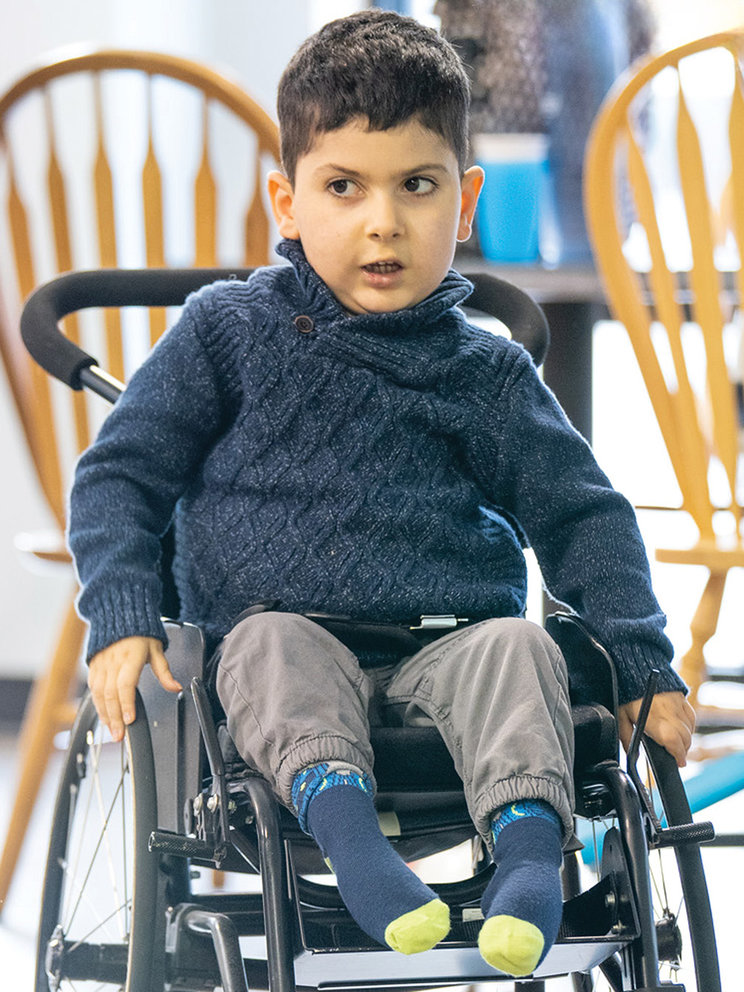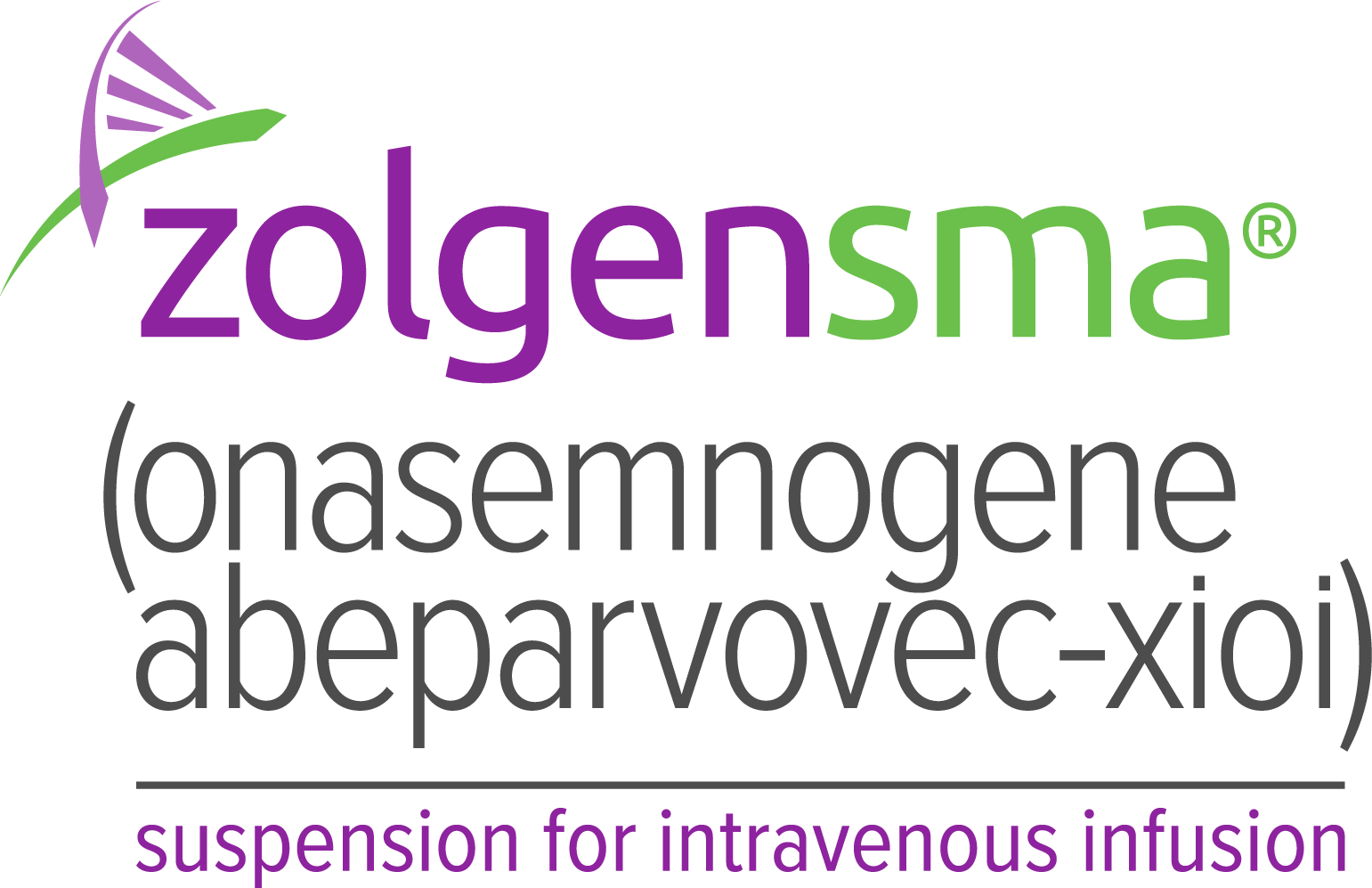ZOLGENSMA is the only one-time gene replacement therapy for SMA
With over 4000 patients treated worldwide,a ZOLGENSMA is designed to treat the genetic root cause of spinal muscular atrophy (SMA). ZOLGENSMA is approved for patients less than 2 years of age with SMA and has been studied in both symptomatic and presymptomatic patients.1,2
aGlobally, including clinical trials, commercially, and through the managed access programs, as of August 2024.1
Long-term follow-up data, up to 9.6 years after treatment, are available for patients who were symptomatic at the time of infusion.3
As of June 2024, long-term follow-up data over 5.8 years after treatment are available for patients who were presymptomatic at the time of infusion.3

"ZOLGENSMA is an attractive option for families because it’s a one-time treatment. They don’t have to come in repeatedly for the treatment itself."
— Dr. Rao, Neuromuscular Medicine, Pediatrics
Baseline tests and post-infusion monitoring for at least 3 months after ZOLGENSMA infusion are required. Administration of a systemic corticosteroid before and after ZOLGENSMA infusion is required.

Maisie, treated at ~20 months
"We still wanted ZOLGENSMA because it’s one-time therapy."
— Ciji, Maisie’s mom

Donovan, treated at ~2 months
"I’m 4-years-old. I’m so excited to start school. When I grow up, I want to be a scientist."
— Donovan, a child with SMA

Brady, treated at ~14 months
"After treatment, Brady’s liver enzymes were elevated, [so] she started monitoring [them] a little closer."
— Nicole, Brady’s mom

Evelyn, treated at ~1 month
"The infusion took about an hour. And in the end, everybody clapped."
— Elena, Evelyn’s mom
Diagnosis and treatment choice
Hear from experts in SMA care on the cause of SMA, how ZOLGENSMA works, and what to expect during the treatment decision conversation.
VOICEOVER:
ZOLGENSMA (onasemnogene abeparvovec-xioi) is a gene therapy for the treatment of pediatric patients less than 2 years of age with spinal muscular atrophy (SMA).
ZOLGENSMA has a Boxed WARNING for Serious Liver Injury and Acute Liver Failure. Please see additional Important Safety Information at the end of this video. Please see the accompanying Full Prescribing Information.
DR SHIEH
The new diagnosis of SMA is an emergency.
DR RAO
A new SMA diagnosis is always emotional.
DR TESI ROCHA
It’s not easy for the families and the patients that come, but it’s also not easy for us.
DR RAO
I think it's both emotional for the families as well as the care provider because it's a very charged environment when you're giving somebody a diagnosis with a disease that can be very progressive and very disabling.
DR SHIEH
So when we get a new diagnosis on a newborn screen, we call the patient immediately and we ask them to come in within days, preferably the next day if possible, so that we can start talking about the diagnosis. It's very important for us to get the ball rolling so that we can map out when we're going to be able to start treatment.
DR RAO
It's a very emotional time, and the amount of information that you want to deliver can be overwhelming.
DR TESI ROCHA
So, when we set up the clinic visit days for those new diagnosis, we make sure that we will have a lot of time to devote to them.
DR SHIEH
When we're explaining SMA nowadays, is we're explaining to a family that their child has a severe progressive devastating disease. But of course, this looks different than the picture that they see of their child who looks like a perfectly healthy baby. And so, it's important for us to give them time so that we can explain and perhaps re-explain what SMA is.
DR RAO
One of the first questions is to keep it very simple and say, "What do you already know? And let's start from there.”
DR TESI ROCHA
There's some families that know a lot, there's some others that this is all new to them. So, for the ones that this is all new to them, I usually use visual aids such as, you know, I like to draw myself to understand something. So, I usually use drawing to explain anything from chromosomes to genes. And then I also work with a genetic counselor, and she usually also brings some visual aids. And I think those are very well taken by the families to understand this very complicated, abstract medical terms.
DR RAO
We start by explaining that Spinal Muscular Atrophy is caused by the absence of the two copies of the SMN1 gene, and then there's a backup gene called the SMN2. Now, the backup gene SMN2 tries to make protein, but it is not enough. And that's why you see the clinical manifestations of Spinal Muscular Atrophy.
DR RAO
Our whole goal is to make sure that they understand as much as they can about all the therapies that are out there in terms of treating SMA. And we're very fortunate to have three therapies. When I'm talking to parents about these three treatments, I tell them that all these three treatments increase the total SMN protein, but in different ways.
DR SHIEH
The SMN1 gene is a gene that’s primarily responsible for making the SMN protein and the SMN protein is what keeps the motor neurons alive. Our patients don’t have an SMN1 gene or that it’s significantly mutated and that the only SMN protein that their child is able to make relies on the SMN2 gene.
DR RAO
ZOLGENSMA increases it by giving back the missing SMN gene, which is the root cause of SMA.
DR SHIEH
The other two therapies work by enhancing the second SMN gene or the SMN2 gene by increasing its efficiency in making SMN protein. One is an oral therapy that needs to be taken daily, and the other is a medication that's injected intrathecally into the spinal fluid and that has to be injected every four months, although there is a loading period of two months.
DR TESI ROCHA
I then go over, you know, the expected outcomes. And for that, I use usually the websites from the different pharmaceutical companies that sponsor these treatments. I feel that, you know, both ZOLGENSMA and the other options are good treatments for the patients, we now have enough data to support that in terms of not only efficacy but safety.
DR RAO
We sit down with families, as a team, and help them make that decision in a shared decision-making model. We do impart a sense of urgency to the families too in terms of making a decision but armed with the full set of knowledge of what each decision means in terms of the benefits and risks.
DR TESI ROCHA
And they ultimately, are the ones making the decision. We certainly can help because I work as a little anthropologist trying to identify, okay, what is the lifestyle of this family? Would this be something that will be able to adhere in terms of follow-ups, visits to the physician?
DR SHIEH
In my experience, ZOLGENSMA is the most attractive and popular choice.
DR RAO
ZOLGENSMA is an attractive option for families because it’s a one-time treatment. They don’t have to come in repeatedly for the treatment itself.
DR TESI ROCHA
But it’s very important to emphasize though that even if it’s a one-time-only patients do need to return for follow ups. It’s not a one-time and done.
DR RAO
Patients need to take steroids after ZOLGENSMA treatment, and even start a day before ZOLGENSMA infusion, because ZOLGENSMA has a Boxed Warning for serious liver injury and acute liver failure.
VOICE-OVER
Please see additional Important Safety Information at the end of this video.
Indication and Important Safety Information for ZOLGENSMA (onasemnogene abeparvovec-xioi)
INDICATION
ZOLGENSMA is an adeno-associated virus (AAV) vector-based gene therapy indicated for the treatment of pediatric patients less than 2 years of age with spinal muscular atrophy (SMA) with bi-allelic mutations in the survival motor neuron 1 (SMN1) gene.
Limitations of Use
The safety and effectiveness of repeat administration or the use in patients with advanced SMA (eg, complete paralysis of limbs, permanent ventilator dependence) has not been evaluated with ZOLGENSMA.
IMPORTANT SAFETY INFORMATION
BOXED WARNING: Serious Liver Injury and Acute Liver Failure
Cases of acute liver failure with fatal outcomes have been reported. Acute serious liver injury, acute liver failure, and elevated aminotransferases can also occur with ZOLGENSMA. Patients with preexisting liver impairment may be at higher risk. Prior to infusion, assess liver function of all patients by clinical examination and laboratory testing. Administer systemic corticosteroid to all patients before and after ZOLGENSMA infusion. Continue to monitor liver function for at least 3 months after infusion, and at other times as clinically indicated. If acute serious liver injury or acute liver failure is suspected, promptly consult a pediatric gastroenterologist or hepatologist.
WARNINGS AND PRECAUTIONS
Systemic Immune Response
Patients with underlying active infection, either acute or chronic uncontrolled, could be at an increased risk of serious systemic immune response. Administer ZOLGENSMA to patients who are clinically stable in their overall health status (eg, hydration and nutritional status, absence of infection). Postpone ZOLGENSMA in patients with infections until the infection has resolved and the patient is clinically stable.
Thrombocytopenia
Transient decreases in platelet counts, some of which met the criteria for thrombocytopenia, were typically observed within the first 2 weeks after ZOLGENSMA infusion. Monitor platelet counts before ZOLGENSMA infusion and on a regular basis for at least 3 months afterwards.
Thrombotic Microangiopathy
Cases of thrombotic microangiopathy (TMA) were reported to occur generally within the first 2 weeks after ZOLGENSMA infusion. TMA can result in life-threatening or fatal outcomes. Obtain baseline creatinine and complete blood count before ZOLGENSMA infusion. Following infusion, monitor platelet counts closely as well as other signs and symptoms of TMA. Consult a pediatric hematologist and/or pediatric nephrologist immediately to manage as clinically indicated.
Elevated Troponin I
Increases in cardiac troponin I levels have occurred following ZOLGENSMA infusion. Consider cardiac evaluation after ZOLGENSMA infusion and consult a cardiologist as needed.
AAV Vector Integration and Risk of Tumorigenicity
There is a theoretical risk of tumorigenicity due to integration of AAV vector DNA into the genome. Cases of tumor have been reported in patients who received ZOLGENSMA post-approval; a causal relationship has not been established based on tumor analysis. In some cases, limited information was available. Report cases of tumor development in patients who received ZOLGENSMA to Novartis Gene Therapies, Inc. at 1-833-828-3947.
Infusion-Related Reactions
Infusion-related reactions, including hypersensitivity reactions and anaphylaxis, have occurred with ZOLGENSMA infusion. Signs and symptoms may include rash, urticaria, vomiting, dyspnea, respiratory symptoms, and/or alterations in heart rate and blood pressure. Monitor patients during and after treatment with ZOLGENSMA. If an infusion-related reaction occurs, interrupt ZOLGENSMA infusion and administer supportive treatment to manage the infusion-related reaction as appropriate. Infusion of ZOLGENSMA may be resumed based on clinical assessment.
ADVERSE REACTIONS
The most commonly observed adverse reactions (incidence ≥5%) in clinical studies were elevated aminotransferases and vomiting.
Please see Full Prescribing Information.
Please visit ZOLGENSMA-hcp.com for more information.
5/25 FA-11426060
